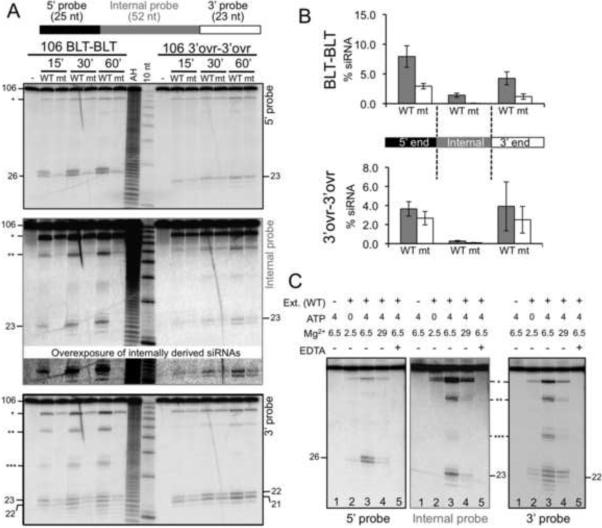Figure 3.
dsRNA with blunt termini give rise to more internally derived siRNAs than those with 3' overhangs. (A) PhosphorImages of northern blots comparing the reaction of 106 BLT-BLT and 3'ovr-3'ovr dsRNA incubated with WT and G492R mutant (mt) extracts for various times, in extract cleavage buffer (10 mM MgOAc; Experimental Procedures). Cartoon shows relative position of probes designed to detect siRNAs generated from termini (top and bottom panels) or middle (middle panel) of dsRNAs. Asterisks denote intermediates, with each representing one cleavage event (*~80 nt, **~57 nt, ***~34 nt). Marked lengths (nts) were determined from data of Figure S1. (B) Data from multiple analyses as in (A) were quantified to determine the average % siRNA (see Figure 2D) for a 60 min incubation with dsRNAs and extracts indicated. Conditions were as in (A) except some reactions contained 6.5 mM MgOAc (control experiments showed no difference in reactions with 6.5 or 10 mM MgOAc). When siRNA bands were heterogeneous, siRNA radioactivity included all proximal bands. Error bars, standard error of the mean (n≥3). (C) Northern blots as in (A) show reaction of 106 BLT-BLT dsRNA incubated for 60 min with WT extract (Ext.) in extract cleavage buffer modified to contain varying amounts of ATP (mM), MgOAc (mM) and EDTA (10 mM). ATP stimulates cleavage and is required for accumulation for internally derived siRNAs (see Figure S2 for overexposure of middle panel). Asterisks, cleavage intermediates as in (A). Marked lengths (nts) were determined from data of Figure S1.

